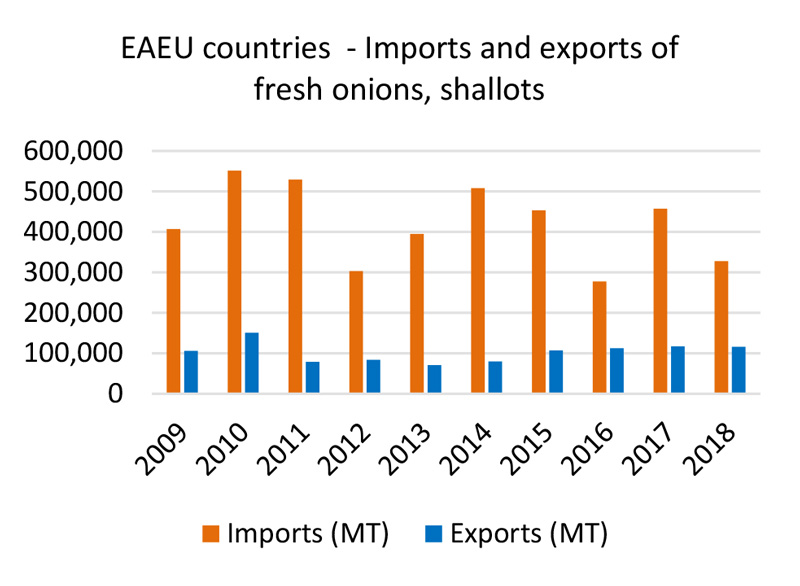By Mark Wocial, Certified Global Business Professional, Wocial & Associates LLC
The Eurasian Economic Union (EAEU) is an economic union of countries located in Central and Northern Asia and Eastern Europe. The EAEU includes Armenia, Belarus, Kazakhstan, Kyrgyzstan and Russia. Although the union came into force in 2015, this article examines longer trends in onion trade involving those countries.

Overall, imports of fresh onions and shallots into the EAEU countries are far greater than exports. According to the United Nations international trade statistics, the five countries imported 328,000 metric tons (MT) of onions in 2018 and exported 116,000 MT. In the 10-year period from 2009 to 2018, imports fluctuated, with a slightly declining overall trend. Exports remained relatively stable.
Russia is the largest importer of fresh onions and shallots in the EAEU area. However, Russian imports declined from a high of 500,000 MT in 2010 to 160,000 MT in 2018. During the same period of time, domestic production increased from 1.5 million MT to over 2.1 million MT. Until 2014, the Netherlands was the leading supplier of onions to Russia. Last year, China was the largest supplier (53,000 MT), followed by Egypt (31,000 MT) and Kazakhstan (30,000 MT). These countries supplied over 70 percent of Russian imports. In contrast to Russia, Kazakhstan’s imports increased significantly in the past decade. In 2018, Kazakhstan imported 151,000 MT, almost entirely from Tajikistan (77,000 MT) and Uzbekistan (72,000 MT). Other EAEU countries are much smaller importers of onions. Last year, Belarus imported 10,000 MT, Armenia 4,400 MT and Kyrgyzstan 2,700 MT.

Kazakhstan was the largest exporter of fresh onions and shallots among the EAEU countries in the last decade. However, the volume of Kazakhstan’s exports remained relatively unchanged, while Russian exports increased significantly. In 2018, Kazakhstan exported 54,000 MT and Russia 45,000 MT. Russia was the largest export market for onions from Kazakhstan (31,000 MT), followed by Poland (8,300 MT), Afghanistan (6,200 MT) and Turkmenistan (3,500 MT).
Last year, Ukraine was the largest export market for Russian onions (27,000 MT), followed by Serbia (6,000 MT), Moldova (3,900 MT) and Romania (3,200 MT). Even prior to the Russian import ban in 2014, U.S. onion exports to Russia were insignificant. Thereafter, there were no U.S. onion exports to any EAEU countries.
Author’s note: This information is based on the author’s analysis of the international trade data collected by the United Nations International Trade Statistics Database, FAOSTAT and the U.S. Census Bureau Foreign Trade Division.

